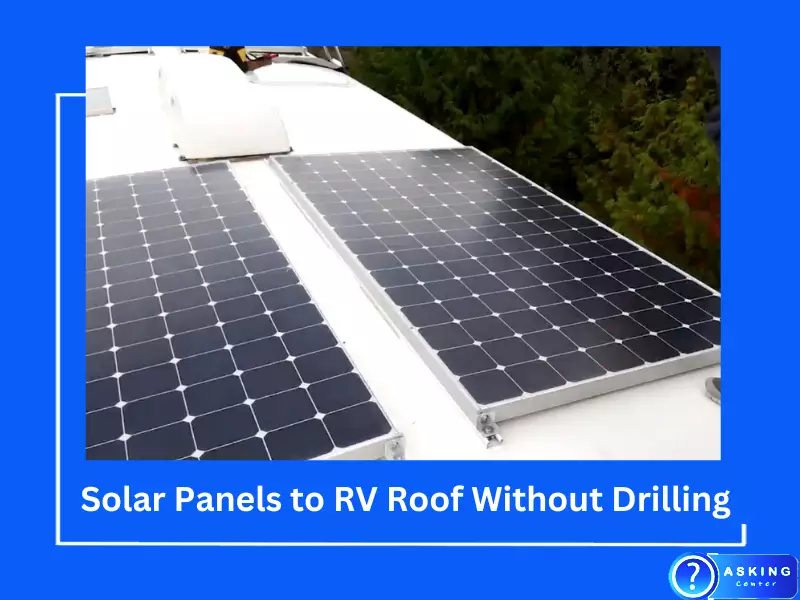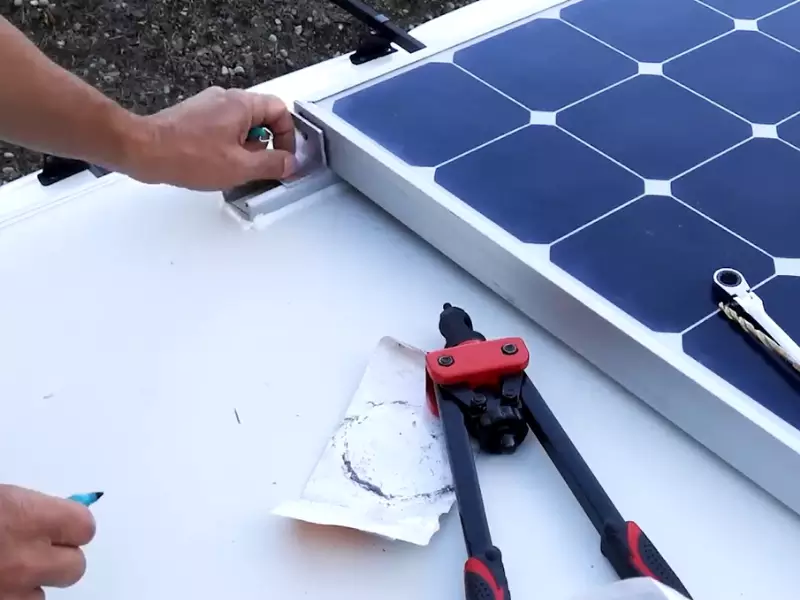Solar energy, harvested by panels, has revolutionized the way we utilize power. This green technology provides a sustainable, clean, and inexpensive source of energy, making it a popular choice amongst homeowners and RV owners alike. However, the task of installing solar panels often raises the question of optimal methods, especially when the aim is to protect the integrity of the structure it is being mounted on.
Installing solar panels without drilling offers an effective solution that preserves both flat and RV roofs. It removes the risk of potential damage associated with drilling, such as water leaks and structural compromise. By harnessing advanced mounting systems and industrial-grade adhesives, we can secure solar panels seamlessly without piercing the roof’s surface.
Delve deeper into this blog to uncover the best ways to mount solar panels on a flat roof or attach them to an RV roof without the need for drilling. This comprehensive guide is filled with relevant insights, practical tips, and step-by-step methods that will empower you to successfully install solar panels while keeping your roof undamaged.
The Basics of Solar Panels
Solar panels capture sunlight and convert it into electricity. They consist of photovoltaic cells that initiate this energy conversion. There are various types of solar panels, each suited for different types of roofs. For instance, traditional rigid panels are suitable for flat roofs, while flexible panels are ideal for curved surfaces like RV roofs.

Reasons to Avoid Drilling for Solar Panel Installation
Structural Integrity
Drilling can potentially harm the structural integrity of roofs. It may create entry points for water, leading to leaks and dampness over time. This can compromise the structural health of the roof, leading to expensive repair or replacement.
Aesthetic Appeal
Drilling into a roof may also affect its aesthetic appeal. Drill holes, even when neatly done, can disrupt the roof’s surface and compromise the overall look of the structure. This might be a crucial consideration for homeowners and RV owners who value the appearance of their property.
Warranty Considerations
It’s also essential to consider that drilling might void any warranty associated with the roof. This could result in unanticipated costs in the event of roof damage or failure, as the warranty may no longer provide cover.
Mounting Solutions for Asphalt Shingle Roofs
When it comes to asphalt shingle roofs, there are several no-drill mounting solutions that can ensure secure and effective solar panel installation.
SolarPod Z-Rack – Aerodynamic Solar Mounting
The SolarPod Z-Rack is an innovative mounting solution that guarantees aerodynamic positioning of the solar panels. This sturdy and durable mounting system does not require roof penetration, ensuring your roof remains intact.
The Z-rack system design employs a Z-shaped pattern that keeps the panels elevated for optimal sunlight exposure, and offers robust resistance against high winds and harsh weather conditions.
S:FLEX Flat Direct – Weighted Solar Mounting
S:FLEX Flat Direct is a renowned mounting system, specifically designed for flat roofs. This system is non-penetrating, utilizing the weight of the panels and additional ballasts to secure the installation.
Its distinct east-west orientation enhances energy yield during peak sunlight hours, making it an energy-efficient solution. The Flat Direct system is highly flexible, allowing for a variety of configuration options to best suit your solar panel layout.

Mounting Solar Panels on Flat Roofs without Drilling
Ballasted Mounting Systems
Ballasted mounting systems rely on the weight of the panels and additional weights to hold them in place. They are convenient and easy to install but may not be suitable for roofs with weight limitations. The installation involves arranging the mounts, placing the weights, and then mounting the panels onto these systems.
Industrial Adhesive Methods
Industrial adhesives provide another effective solution. These high-strength glues bond the mounting hardware to the roof. They are highly resistant to weather and aging but must be used precisely to avoid any gaps that could lead to instability. The installation process involves applying the adhesive to the mounts, placing them on the roof, and securing the panels to the mounts.
Lightweight Solutions for Solar Panel Mounting
Several lightweight options facilitate the mounting of solar panels without the need for drilling, reducing strain on the structure and ensuring ease of installation.
Thin-Film PV Solar Laminates
Thin-film PV solar laminates are exceptionally lightweight solar panel alternatives. These can be directly adhered to the roofing material, making them suitable for roofs that cannot tolerate heavy loads. These laminates are flexible, allowing them to conform to the shape of the roof surface, and their adhesive backing eliminates the need for traditional mounting systems.
Solar Stack – Pedestal Solar Panel Mounting
Solar Stack offers a unique, non-invasive mounting system. This pedestal mounting design does not require roof penetration. Instead, it uses a high-strength adhesive to secure the mounts onto the roof, with the panels then attached to these mounts. The pedestals distribute the weight of the panels evenly across the roof, mitigating the risk of localized pressure damage.
Attaching Solar Panels to RV Roofs without Drilling
Flexible Solar Panels
Flexible solar panels conform to the shape of the RV roof, making them a preferred choice for such installations. They are lightweight and can be attached using adhesives. Installation involves cleaning the roof, applying the adhesive to the back of the panels, and pressing them onto the roof.

Mounting Tapes and VHB Tapes
Mounting tapes or Very High Bond (VHB) tapes are double-sided adhesive tapes that offer a strong bond. They are resistant to temperature changes and weather effects. Installation involves cleaning the roof, applying the tape to the mounts or directly to the panels, and attaching them to the roof.
No-Drill Solar Panels for Flat Roofs
Flat roofs are common, especially in commercial buildings, and there are numerous non-invasive installation methods suited to them.
Ballasted Mounts
We’ve already mentioned the concept of ballasted mounts, but it’s worth reiterating their effectiveness for flat roofs. These systems are designed to use the weight of the panels and additional ballasts to anchor them securely, eliminating the need for roof penetration.
Plates or Concrete Blocks
Another method is to use plates or concrete blocks as a counterweight to secure the solar panels. This strategy is commonly used with a racking system, where the weight of the blocks keeps the rack and panels in place.
Metal Trusses
Metal trusses, when combined with a weighted system, can offer a reliable non-drilling solution. These trusses are placed across the roof, and the solar panels are then attached to these structures, ensuring they are secure and elevated for optimal sunlight exposure.
Stand-Alone Solar Rack – Mounting Alternative
Stand-alone solar racks provide a viable alternative for individuals who can’t or don’t want to install solar panels directly on their roofs. These racks can be installed on the ground, independent of any building structures.
Mount Panels South-Facing
For maximum solar efficiency, these standalone racks should be oriented to face south in the northern hemisphere, allowing them to capture the most sunlight throughout the day. Stand-alone racks offer a high degree of flexibility, as they can be placed anywhere on the property that receives ample sunlight.

Pre-Installation Considerations
Before starting the installation, several factors need to be taken into account.
Solar Potential
This refers to the amount of sunlight your location receives throughout the year. Areas with high solar potential can generate more electricity from solar panels, making them more efficient.
Direction and Angle of Installation
The direction and angle of panel installation are crucial for capturing optimal sunlight. In the northern hemisphere, panels should face south, while in the southern hemisphere, they should face north. The angle should also be adjusted according to the latitude of your location.
Roof Size and Panel Size
Assessing the roof size in relation to the panel size is vital. A roof that is too small may not support the desired number of panels, while a larger roof offers more flexibility in the size and number of panels that can be installed.
Regular Maintenance and Inspection
Regardless of the installation method, regular checks for stability and efficiency are vital. It’s crucial to monitor for any signs of loosening mounts or panels, and weather implications like heavy snowfall or strong winds. If any issues arise, professional assistance should be sought.
FAQs
Can I install solar panels myself without drilling?
Yes, you can. However, it requires a certain level of skill, and safety should always be a priority. Always follow manufacturer guidelines or consult with a professional if you’re unsure.
How to connect solar panels?
Solar panels are connected in a series or parallel configuration depending on your power requirements. They are then connected to an inverter which converts the generated DC power into AC power for use in your home or RV.
Are adhesive methods reliable for mounting solar panels?
Yes, if applied correctly, adhesive methods can offer a strong and lasting bond for solar panel installations.
How often should I inspect my solar panels?
It’s recommended to perform a basic inspection every six months. However, it’s advisable to check for any issues after extreme weather conditions.
Conclusion
Harnessing solar power through the installation of panels on your roof, be it flat or an RV, is a significant stride towards sustainable living. However, the mounting process should not compromise the structural integrity of your home or vehicle.
Hence, alternatives to drilling, such as ballasted mounting systems, industrial adhesives, flexible solar panels, and VHB tapes, serve as reliable, effective solutions. Regular maintenance and inspection of your installation are essential to ensure the longevity and effectiveness of your solar panels.
Embracing these installation methods allows us to step into a future where we are no longer solely reliant on traditional energy sources. With this transition, we ensure the preservation of our planet, one solar panel at a time.
